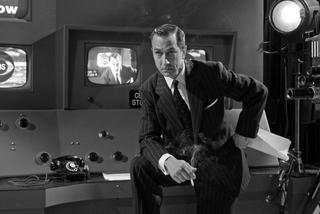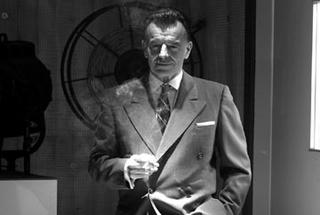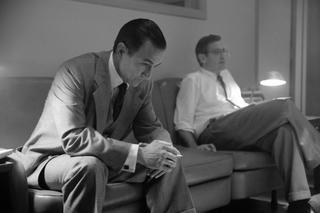Broadcast Snooze
 [To read Humby's Positive Review Click Here.]
[To read Humby's Positive Review Click Here.]George Clooney shows real growth as an artist with his film GOOD NIGHT, AND GOOD LUCK. (He produced, directed and co-wrote the script with familiar character-actor Grant Heslov.) Clooney brings a mature humility to the story of a group of journalists (led by Edward R. Murrow) who took on Senator Joseph McCarthy during the communist witch-hunts of the 1950’s.
Unfortunately, Clooney’s film is way too much documentary, not nearly enough docu-drama, and he drains the blood from his hot-blooded subject with jazz, a pointless subplot, an obvious subplot and liberal use of real footage which continually bring dramatic momentum to a stand still.
 GOOD NIGHT is far from a failure. It hardly even counts as a misfire. There’s so much the movie does well that I could almost recommend it. In particular, I loved the way Clooney recreates a time when newsmen were the voice of the people, not a tool for political propaganda. These mavericks criticized our government and its policies in order to bring about change. And in the world of broadcast journalism, Murrow stood (and still stands) as their Michael Jordan.
GOOD NIGHT is far from a failure. It hardly even counts as a misfire. There’s so much the movie does well that I could almost recommend it. In particular, I loved the way Clooney recreates a time when newsmen were the voice of the people, not a tool for political propaganda. These mavericks criticized our government and its policies in order to bring about change. And in the world of broadcast journalism, Murrow stood (and still stands) as their Michael Jordan.Murrow is played by David Stratharian, an actor so good at BECOMING a character (rather than just creating one) that he will probably never be recognized as the leading man he so clearly could be. (His authoritative face takes on a matinee idol quality in the crisp Black & White photography.) The same way that Clooney is effortlessly charismatic, Stratharian makes Murrow thoroughly compelling. Even in a room full of wonderful actors, your attention is drawn to him.
 Don’t look for his name come Oscar time, however. Murrow is never shown having any life outside of his crusade. The man on camera is pretty much the same man we get behind the scenes. The same can be said of the entire film. So set is Clooney on presenting this one piece of history, that almost anything that would breathe life and layers into the characters is squashed out by the film’s brief 90 minute running time. (It’s as if biographical data on these people didn’t exist and Clooney felt it would be dishonest to make stuff up.)
Don’t look for his name come Oscar time, however. Murrow is never shown having any life outside of his crusade. The man on camera is pretty much the same man we get behind the scenes. The same can be said of the entire film. So set is Clooney on presenting this one piece of history, that almost anything that would breathe life and layers into the characters is squashed out by the film’s brief 90 minute running time. (It’s as if biographical data on these people didn’t exist and Clooney felt it would be dishonest to make stuff up.)That being said, the film does wander inexplicably away from its focus, and my attention often wandered with it.
First of all, the film stops – Stops Dead – about three times for jazz. In the building (don’t ask me why) there’s a woman (Dianne Reeves) recording jazz songs and the movie will take a break while she sings. The songs don’t connect to the story – Maybe emotionally they do. In full confession, I do not like jazz music. – and the images do little to advance the plot. (Shots of the actors mostly feel grabbed from deleted scenes.) It’s just padding. Plain and simple.
 There’s also a subplot with Robert Downey Jr. and Patricia Clarkson as co-workers sharing a secret romance. The actors have great chemistry together, and a scene late in the film with Jeff Daniels (criminally underused as always) is really charming. But when all is said and done, their story bears no weight on the rest of the film.
There’s also a subplot with Robert Downey Jr. and Patricia Clarkson as co-workers sharing a secret romance. The actors have great chemistry together, and a scene late in the film with Jeff Daniels (criminally underused as always) is really charming. But when all is said and done, their story bears no weight on the rest of the film.Another subplot involving Ray Wise as a fellow news anchor hits every predictable note on the way to a melodramatic coda so obvious it was cliché back when McCarthyism took place.
 The clips with Senator Joseph McCarthy are so plentiful, so long, it raises the question of why not do the same with Murrow? Why even bother with the behind-the-scenes moments when Clooney could have just played the actual broadcasts?
The clips with Senator Joseph McCarthy are so plentiful, so long, it raises the question of why not do the same with Murrow? Why even bother with the behind-the-scenes moments when Clooney could have just played the actual broadcasts?Oh, right…then he wouldn’t have a movie, he’d have a documentary. Guess what? That’s pretty much what he’s got anyway. Remove the broadcasts, the news clips, the subplots and the jazz music and there’s about 20 minutes of actual cinema.
I liked that Clooney simply shows what televised news was like then and we draw our own conclusions to how far we’ve strayed from the journalistic path. (This film should easily be a favorite of journalistic reformist Jon Stewart.) But the film is more like a dry civics lecture than an exciting cinematic experience. A better film would have wrapped its medicine in some cinematic chocolate, making it a tastier message to swallow.




0 Comments:
Post a Comment
<< Home